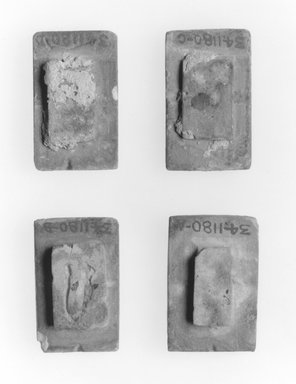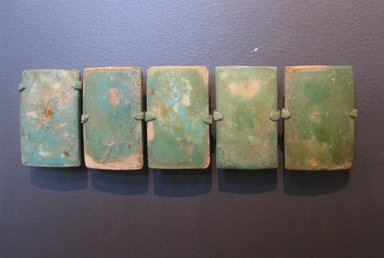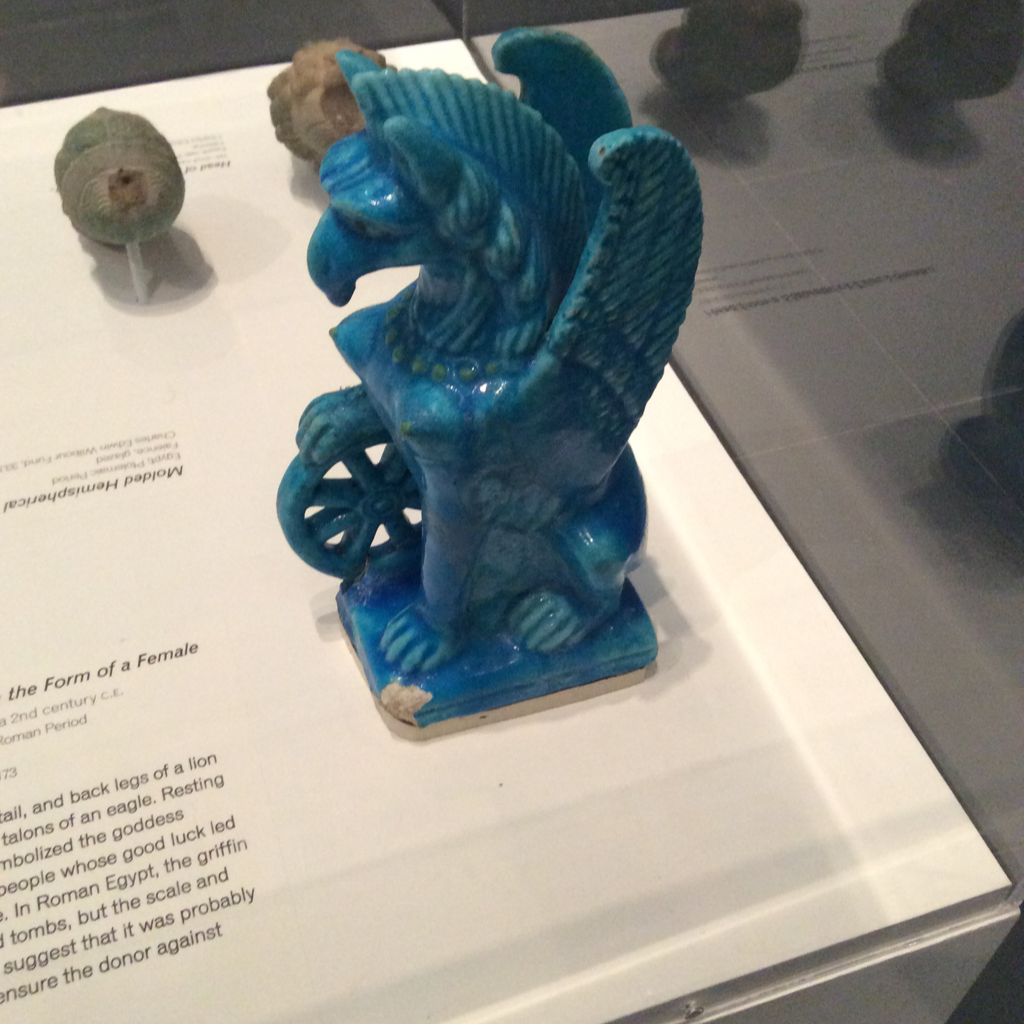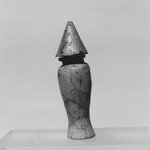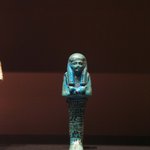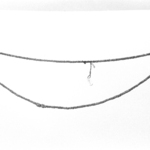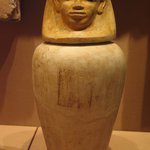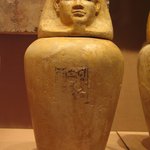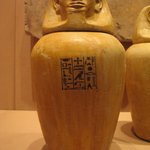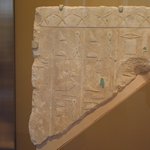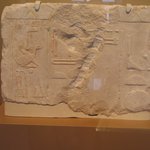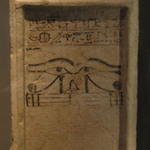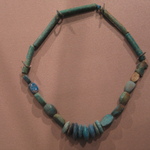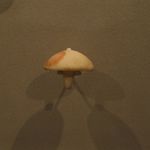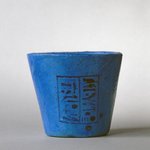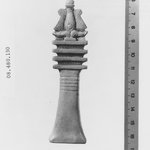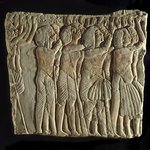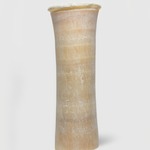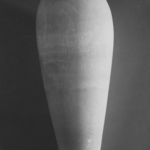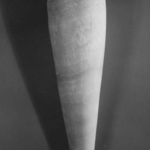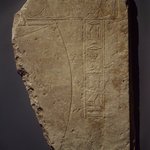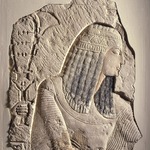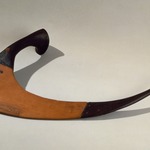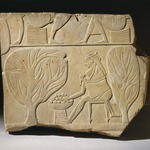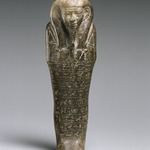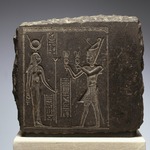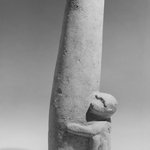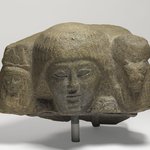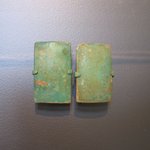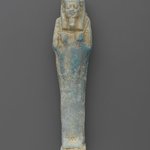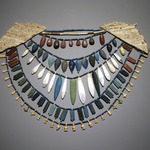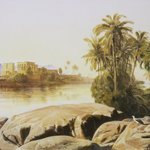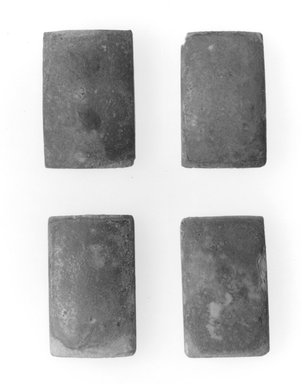

Wall Tile from a Royal Funerary Structure, ca. 2675–2625 B.C.E. Faience, 2 5/16 × 1 1/2 × 9/16 in. (5.8 × 3.8 × 1.4 cm). Brooklyn Museum, Charles Edwin Wilbour Fund, 34.1180a. Creative Commons-BY (Photo: , CUR.34.1180a_34.1180b_34.1180c_34.1180d_NegA_print_bw.jpg)
Wall Tile from a Royal Funerary Structure
Egyptian, Classical, Ancient Near Eastern Art
Blue-green glazed rectangular tiles like these once decorated the walls of subterranean rooms beneath King Djoser’s Step Pyramid. As the first example of monumental stone architecture in Egypt, Djoser’s funerary complex was meant to provide the king’s spirit with an abode for eternity. The tiles imitated the hangings of reeds lashed together by horizontal cords that decorated palace walls during this king’s lifetime.
MEDIUM
Faience
DATES
ca. 2675–2625 B.C.E.
DYNASTY
Dynasty 3
PERIOD
Early Old Kingdom
DIMENSIONS
2 5/16 × 1 1/2 × 9/16 in. (5.8 × 3.8 × 1.4 cm) (show scale)



COLLECTIONS
Egyptian, Classical, Ancient Near Eastern Art
ACCESSION NUMBER
34.1180a
CREDIT LINE
Charles Edwin Wilbour Fund
CATALOGUE DESCRIPTION
One of four green glazed faience plaques from the lining of the subterranean chamber in the pyramid of King Zoser at Saqqarah. The plaques are oblong and undecorated. On the underside of each is an oblong ridge which is pierced apparently to facilitate attachment to the walls of the chamber.
Condition, each tile is slightly chipped and on the rear are remains of plaster.
EXHIBITIONS
MUSEUM LOCATION
This item is not on view
CAPTION
Wall Tile from a Royal Funerary Structure, ca. 2675–2625 B.C.E. Faience, 2 5/16 × 1 1/2 × 9/16 in. (5.8 × 3.8 × 1.4 cm). Brooklyn Museum, Charles Edwin Wilbour Fund, 34.1180a. Creative Commons-BY (Photo: , CUR.34.1180a_34.1180b_34.1180c_34.1180d_NegA_print_bw.jpg)
IMAGE
group, CUR.34.1180a_34.1180b_34.1180c_34.1180d_NegA_print_bw.jpg.
"CUR" at the beginning of an image file name means that the image was created by a curatorial staff member. These study images may be digital point-and-shoot photographs, when we don\'t yet have high-quality studio photography, or they may be scans of older negatives, slides, or photographic prints, providing historical documentation of the object.
RIGHTS STATEMENT
Creative Commons-BY
You may download and use Brooklyn Museum images of this three-dimensional work in accordance with a Creative Commons license. Fair use, as understood under the United States Copyright Act, may also apply.
Please include caption information from this page and credit the Brooklyn Museum. If you need a high resolution file, please fill out our online application form (charges apply).
For further information about copyright, we recommend resources at the United States Library of Congress, Cornell University, Copyright and Cultural Institutions: Guidelines for U.S. Libraries, Archives, and Museums, and Copyright Watch.
For more information about the Museum's rights project, including how rights types are assigned, please see our blog posts on copyright.
If you have any information regarding this work and rights to it, please contact copyright@brooklynmuseum.org.
RECORD COMPLETENESS
Not every record you will find here is complete. More information is available for some works than for others, and some entries have been updated more recently. Records are frequently reviewed and revised, and we welcome any additional information you might have.
